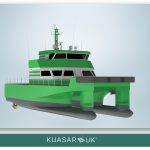Lookout Awareness of Distractions The creation of a Distraction Evaluation Ratio (LADDER) led by Liverpool John Moores University
65% of ship collisions result from improper lookout and the root cause of underlying issues appears to be a lack of definition of the term ‘proper lookout’ leading to a lack of appreciation for the shortfalls that need to be addressed to improve watchkeeper behaviour.
The International Regulations for Preventing Collisions at Sea (IRPCS) require ships’ Officers of the Watch (OOWs) to maintain a proper lookout by sight despite provision of multifunction displays (MFDs) to reduce workload and improve Situational Awareness (SA). The OOWs now need to spend more time on gathering information from MFDs but the impact of this as a distraction from maintaining a visual lookout has not been evaluated.
A definition for the term ‘proper lookout’ is provided, and it was proposed to amend the International Code on Standards of Training, Certification and Watchkeeping for Seafarers (STCW Code) by inclusion of this definition. A suitable definition will assist in enabling its better application in the context of human eye functionality both during the day and at night together with mitigation of distraction impact caused by MFDs. The underlying research studies this impact by using Eye Tracking Devices (ETDs) in bridge simulators and on real ships by comparing watchkeepers’ eye movement data on simulator bridge without any MFDs with the bridge with full MFDs to establish a ‘base’ distraction evaluation ratio (DER).

After establishing the DER, the concept of Centre Console Display (CCD) was introduced to facilitate provision of reduced but most relevant collision avoidance and navigational information to the OOW to lower MFD related distractions. Drawing from the research in aviation industry, the research also introduces a scan pattern that can be applied by the OOWs together with the CCD concept and then evaluates the data captured on simulator bridges. Finally, ETD data captured on real ships is used to validate the simulator data.
In conclusion, it is established that when the watchkeepers are trained in utilising a scan pattern to maintain a lookout, their lookout effectiveness improves by following the recommended scan pattern. A further reduction in distractions caused by MFDs is also demonstrated through implementing the CCD concept. The research also establishes that due to a lack of guidance on scan patterns, the watchkeepers are never educated to train their eyes correctly for maintaining a lookout, thus they never apply any technique to maintain an optimum ‘proper lookout’ as required by the IRPCS or the STCW Code.
The outputs from this work are directly shared with the industry and the regulators through published articles and journal papers.
Any enquiry, please contract Dr Abdul Khalique through A.Khalique@ljmu.ac.uk

University of Liverpool Final Report
Send download link to:


